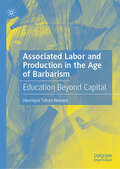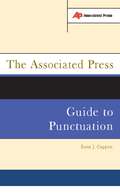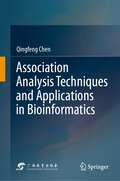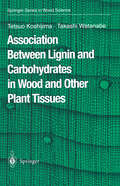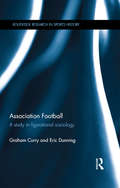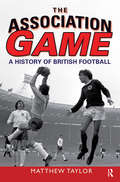- Table View
- List View
Assistive Technology Intervention in Healthcare
by Shruti Jain Sudip PaulAssistive Technology Intervention in Healthcare focuses on various applications of intelligent techniques in biomedical engineering and health informatics. It aims to create awareness about disability reduction and recovery of accidental disability with the help of various rehabilitative systems. Novel technologies in disability treatment, management and assistance, including healthcare devices and their utility from home to hospital, are described. The book deals with simulation, modeling, measurement, control, analysis, information extraction and monitoring of physiological data in clinical medicine and biology. Features Covers the latest evolutionary approaches to solve optimization problems in the biomedical engineering field Explains machine learning–based approaches to improvement in health engineering areas Reviews the IoT, cloud computing and data analytics in healthcare informatics Discusses modeling and simulations in the design of biomedical equipment Explores monitoring of physiological data This book is aimed at researchers and graduate students in biomedical engineering, clinical engineering and bioinformatics.
Assistive Technology to Support Inclusive Education (International Perspectives on Inclusive Education #14)
by Dianne ChambersIn this edited collection, experienced practitioners discuss how a range of existing and emerging assistive technology devices and services are used across a variety of international settings to support the inclusion of students with disabilities. This book details authentic examples of best practice, including identification and implementation of appropriate tools, the use of aided communication devices, modified seating equipment, computers and tablets, robotics, costs, outcomes, and services among others. It showcases a spectrum of promising and positive results in reducing exclusion, thereby supporting teachers to improve learning outcomes for students with disabilities. By providing an excellent and current overview of assistive technology and the use of the technology in the classroom, this book is an insightful read for those who work with technology and the inclusion of students with disabilities. The authors demonstrate how specialists, teachers, parents and students can work together using technology to ensure inclusive education is a realistic goal for all.
Assistive Technology to Support Inclusive Education (International Perspectives on Inclusive Education #14)
by Dianne Chambers Chris ForlinIn this edited collection, experienced practitioners discuss how a range of existing and emerging assistive technology devices and services are used across a variety of international settings to support the inclusion of students with disabilities. This book details authentic examples of best practice, including identification and implementation of appropriate tools, the use of aided communication devices, modified seating equipment, computers and tablets, robotics, costs, outcomes, and services among others. It showcases a spectrum of promising and positive results in reducing exclusion, thereby supporting teachers to improve learning outcomes for students with disabilities. By providing an excellent and current overview of assistive technology and the use of the technology in the classroom, this book is an insightful read for those who work with technology and the inclusion of students with disabilities. The authors demonstrate how specialists, teachers, parents and students can work together using technology to ensure inclusive education is a realistic goal for all.
Associahedra, Tamari Lattices and Related Structures: Tamari Memorial Festschrift (Progress in Mathematics #299)
by Folkert Müller-Hoissen Jean Marcel Pallo Jim StasheffTamari lattices originated from weakenings or reinterpretations of the familar associativity law. This has been the subject of Dov Tamari's thesis at the Sorbonne in Paris in 1951 and the central theme of his subsequent mathematical work. Tamari lattices can be realized in terms of polytopes called associahedra, which in fact also appeared first in Tamari's thesis. By now these beautiful structures have made their appearance in many different areas of pure and applied mathematics, such as algebra, combinatorics, computer science, category theory, geometry, topology, and also in physics. Their interdisciplinary nature provides much fascination and value. On the occasion of Dov Tamari's centennial birthday, this book provides an introduction to topical research related to Tamari's work and ideas. Most of the articles collected in it are written in a way accessible to a wide audience of students and researchers in mathematics and mathematical physics and are accompanied by high quality illustrations.
Associated Labor and Production in the Age of Barbarism: Education Beyond Capital
by Henrique Tahan NovaesThe book focuses on different practices of associated labor in Brazil and Argentina, in the case of the workers’ recuperated factories, over the past 40 years. Novaes analyses labor practices from a critical Marxist perspective as a reaction to the misery of neoliberalism. Deindustrialization, austerity programs, increasing commodification and international competitiveness have severely deteriorated the living and working conditions of the majority of Latin Americans. However, alternative labor, production and educational practices have developed in this increasingly ruthless neoliberal capitalism. Although they are still small, they indicate a potential way out of the capitalist mode of production. Novaes directs his special attention to the “education beyond capital,” which has accompanied these alternative labor and production practices (from alternative job training in recuperated companies and the movement of landless rural workers MST).
Associated Press Coverage of a Major Disaster: The Crash of Delta Flight 1141 (Routledge Library Editions: Journalism)
by Thomas FenschOriginally published in 1989. This diary of a news event looks at how the reporting happened as spread by the news wire system of the Associated Press service in America. Analysing the flow of information in this detailed way, this book presents how a major disaster, a fast-moving story with considerable spin, was fed out to the press via the Dallas bureau in 1988. Introductory chapters outline the workings of a press bureau office during a major story and present interview sections with key reporters on the story about how their role unfolded. Sidebar commentary alongside the reproductions of the news wires, organised by date and time, adds interesting discussion throughout the book, while a conclusion evaluates the coverage of the story. The Appendices include reproductions of Texas newspapers’ resulting pages about the crash. This is a fascinating case-study of the dissemination of news date before the internet, compiled at a time when computers were just large enough to retain in memory all stories relating to event ‘X’ in order for this kind of analysis to be attempted.
Associated Press Coverage of a Major Disaster: The Crash of Delta Flight 1141 (Routledge Library Editions: Journalism)
by Thomas FenschOriginally published in 1989. This diary of a news event looks at how the reporting happened as spread by the news wire system of the Associated Press service in America. Analysing the flow of information in this detailed way, this book presents how a major disaster, a fast-moving story with considerable spin, was fed out to the press via the Dallas bureau in 1988. Introductory chapters outline the workings of a press bureau office during a major story and present interview sections with key reporters on the story about how their role unfolded. Sidebar commentary alongside the reproductions of the news wires, organised by date and time, adds interesting discussion throughout the book, while a conclusion evaluates the coverage of the story. The Appendices include reproductions of Texas newspapers’ resulting pages about the crash. This is a fascinating case-study of the dissemination of news date before the internet, compiled at a time when computers were just large enough to retain in memory all stories relating to event ‘X’ in order for this kind of analysis to be attempted.
The Associated Press Guide To Internet Research And Reporting
by Frank BassHow does a reporter go about researching a story on the Internet and how does one fact check and cite online sources? What are the copyright issues involved in quoting Internet sources? How does one go about selling a story to Internet sites? How does one physically file a story on-line? Answers to these and many more twenty-first-century journalism questions can be found in The Associated Press Guide to Internet Research and Reporting. The final word on the rules of Internet reporting, this comprehensive guide will be the on-line style guide of choice for AP staff, stringers, and journalism students alike.
The Associated Press Guide To Punctuation
by Rene J. CapponIn the no-nonsense, authoritative tradition of the best-selling AP Stylebook, the top editors at the AP have written the definitive guide to punctuation. More people write for the Associated Press than for any other news service, and more writers take their style and word-usage cues from this world-famous institution than from any other journalism source. From the when and how of the ampersand to the rules for dashes, slashes, and brackets; from the correct moment for the overused exclamation point to the rules of engagement for the semicolon, The AP Guide to Punctuation is an invaluable and easy-to-use guide to the most important aspect of clear and persuasive writing.
Associated Production of W + Charm in 13 TeV Proton-Proton Collisions Measured with CMS and Determination of the Strange Quark Content of the Proton (Springer Theses)
by Svenja Karen PflitschThe associated production of a W boson and a single charm quark (W+c) is the only process in proton-proton collisions that directly probes the strange quark content of the proton. In this thesis, W+charm production is measured in proton-proton collisions at the LHC at 13 TeV, as recorded by the Compact Muon Solenoid (CMS) experiment. The analysis focuses on the identification of W bosons in their leptonic decay to a muon and a neutrino and charm quarks are tagged via the full reconstruction of D*-Mesons.The measured cross sections of W+c production are used, in combination with other relevant CMS results and the most precise HERA DIS data, in a QCD analysis to determine the strange quark content of the proton. The resulting strange quark distribution and suppression, with respect to the other light sea quarks, are in good agreement with those obtained in neutrino scattering experiments and extend their kinematic reach.
Associated Sequences, Demimartingales and Nonparametric Inference (Probability and Its Applications)
by B.L.S. Prakasa RaoThis book gives a comprehensive review of results for associated sequences and demimartingales developed so far, with special emphasis on demimartingales and related processes. Probabilistic properties of associated sequences, demimartingales and related processes are discussed in the first six chapters. Applications of some of these results to some problems in nonparametric statistical inference for such processes are investigated in the last three chapters.
Associated Studies for Motor Vehicle Mechanics: (pdf) (Macmillan Motor Vehicle Engineering Series)
by J. Hirst P. H. SeedAssociation Analysis Techniques and Applications in Bioinformatics
by Qingfeng ChenAdvances in experimental technologies have given rise to tremendous amounts of biology data. This not only offers valuable sources of data to help understand biological evolution and functional mechanisms, but also poses challenges for accurate and effective data analysis. This book offers an essential introduction to the theoretical and practical aspects of association analysis, including data pre-processing, data mining methods/algorithms, and tools that are widely applied for computational biology. It covers significant recent advances in the field, both foundational and application-oriented, helping readers understand the basic principles and emerging techniques used to discover interesting association patterns in diverse and heterogeneous biology data, such as structure-function correlations, and complex networks with gene/protein regulation. The main results and approaches are described in an easy-to-follow way and accompanied by sufficientreferences and suggestions for future research. This carefully edited monograph is intended to provide investigators in the fields of data mining, machine learning, artificial intelligence, and bioinformatics with a profound guide to the role of association analysis in computational biology. It is also very useful as a general source of information on association analysis, and as an overall accompanying course book and self-study material for graduate students and researchers in both computer science and bioinformatics.
Association and Auditory Cortices (Cerebral Cortex #4)
by Alan Peters Edward G. JonesThis volume deals with some of the association areas of the cerebral cortex and with the auditory cortex. In the first chapter, by Deepak Pandya and Edward Yeterian, the general architectural features and connections of cortical associ ation areas are considered; as these authors point out, in primates the association areas take up a considerable portion of the total cortical surface. Indeed, it is the development of the association areas that accounts for the greatest differ ences between the brains of primate and non primate species, and these areas have long been viewed as crucial in the formation of higher cognitive and be havioral functions. In the following chapter, Irving Diamond, David Fitzpatrick, and James Sprague consider the question of whether the functions of the as sociation areas depend on projections from the sensory areas of the cortex. They use the visual cortex to examine this question and show that there is a great deal of difference between species in the amount of dependence, the differences being paralleled by variations in the manner in which the geniculate and pulvinar nuclei of the thalamus project to the striate and extra striate cortical areas. One of the more interesting and perhaps least understood of the association areas is the cingulate cortex, discussed by Brent Vogt. Cingulate cortex has been linked with emotion and with affective responses to pain, and in his chapter Vogt gives an account of its cytoarchitecture, connections, and functions.
Association Between Lignin and Carbohydrates in Wood and Other Plant Tissues (Springer Series in Wood Science)
by Tetsuo Koshijima Takashi WatanabeAssociation Football: A Study in Figurational Sociology (Routledge Research in Sports History)
by Graham Curry Eric DunningThis book presents a synthesis of the work on early football undertaken by the authors over the past two decades. It explores aspects of a figurational approach to sociology to examine the early development of football rules in the middle part of the nineteenth century. The book tests Dunning’s status rivalry hypothesis to contest Harvey’s view of football’s development which stresses an influential sub-culture outside the public schools. Status Rivalry re-states the primacy of these latter institutions in the growth of football and without it the sport’s story would remain skewed and unbalanced for future generations.
Association Football: A Study in Figurational Sociology (Routledge Research in Sports History)
by Graham Curry Eric DunningThis book presents a synthesis of the work on early football undertaken by the authors over the past two decades. It explores aspects of a figurational approach to sociology to examine the early development of football rules in the middle part of the nineteenth century. The book tests Dunning’s status rivalry hypothesis to contest Harvey’s view of football’s development which stresses an influential sub-culture outside the public schools. Status Rivalry re-states the primacy of these latter institutions in the growth of football and without it the sport’s story would remain skewed and unbalanced for future generations.
Association Football and English Society, 1863-1915 (Routledge Soccer Histories)
by Tony MasonAssociation football, as it developed rapidly in the late-nineteenth and early-twentieth centuries, both reflected British society and helped to reshape it. In this newly released edition of Tony Mason’s essential account of the game’s rise, focusing on issues such as the amateur–professional divide, social class and mass spectatorship are seen as fundamental to our understanding of what is now a global phenomenon. Dilwyn Porter supplements this classic text with a brand new introduction.
Association Football and English Society, 1863-1915 (Routledge Soccer Histories)
by Tony MasonAssociation football, as it developed rapidly in the late-nineteenth and early-twentieth centuries, both reflected British society and helped to reshape it. In this newly released edition of Tony Mason’s essential account of the game’s rise, focusing on issues such as the amateur–professional divide, social class and mass spectatorship are seen as fundamental to our understanding of what is now a global phenomenon. Dilwyn Porter supplements this classic text with a brand new introduction.
The Association Game: A History of British Football
by Matthew TaylorThe story of British football's journey from public school diversion to mass media entertainment is a remarkable one. The Association Game traces British football from the establishment of the earliest clubs in the nineteenth century to its place as one of the prominent and commercialised leisure industries at the beginning of the twenty first century. It covers supporters and fandom, status and culture, big business, the press and electronic media and development in playing styles, tactics and rules. This is the only up to date book on the history of British football, covering the twentieth century shift from amateur to professional and whole of the British Isles, not just England.
The Association Game: A History of British Football
by Matthew TaylorThe story of British football's journey from public school diversion to mass media entertainment is a remarkable one. The Association Game traces British football from the establishment of the earliest clubs in the nineteenth century to its place as one of the prominent and commercialised leisure industries at the beginning of the twenty first century. It covers supporters and fandom, status and culture, big business, the press and electronic media and development in playing styles, tactics and rules. This is the only up to date book on the history of British football, covering the twentieth century shift from amateur to professional and whole of the British Isles, not just England.
The Association Guide to Going Global: New Strategies for a Changing Economic Landscape
by Steven WorthWhy going global is critical-and inevitable-for your association's growth and survival Multiple case studies of associations that have entered the global arena will be included. The Association Guide to Going Global demonstrates how many associations have used globalization to their advantage, finding that increasing their reach and influence on an international scale has allowed their organizations continued success. Underscores how the advantages of changes outweigh the risks How adapting to new market trends is an act that cannot, and should not, be avoided Offers a problem-solution guide to potentially intimidating questions about the process Explains how small associations may often have an advantage over large corporations due to flexibility Coverage features topics including an overview of problems encountered, structure, funding/financing, language and culture, endeavors in specific countries, successes and failures, and what it means to truly become global. Avoid mistakes made by other organizations by going global and ultimately following the paths of those who accomplished their goals.
The Association Guide to Going Global: New Strategies for a Changing Economic Landscape
by Steven WorthWhy going global is critical-and inevitable-for your association's growth and survival Multiple case studies of associations that have entered the global arena will be included. The Association Guide to Going Global demonstrates how many associations have used globalization to their advantage, finding that increasing their reach and influence on an international scale has allowed their organizations continued success. Underscores how the advantages of changes outweigh the risks How adapting to new market trends is an act that cannot, and should not, be avoided Offers a problem-solution guide to potentially intimidating questions about the process Explains how small associations may often have an advantage over large corporations due to flexibility Coverage features topics including an overview of problems encountered, structure, funding/financing, language and culture, endeavors in specific countries, successes and failures, and what it means to truly become global. Avoid mistakes made by other organizations by going global and ultimately following the paths of those who accomplished their goals.
Association Mapping in Plants
by Nnadozie C. Oraguzie Susan E. Gardiner Erik H. A. Rikkerink H. Nihal De SilvaThis book provides both basic and advanced understanding of association mapping and an awareness of population genomics tools to facilitate mapping and identification of the underlying causes of quantitative trait variation in plants. It acts as a useful review of the marker technology, the statistical methodology, and the progress to date. It also offers guides to the use of single nucleotide polymorphisms (SNPs) in association studies.
Association Models in Epidemiology: Study Designs, Modeling Strategies, and Analytic Methods (Chapman & Hall/CRC Biostatistics Series)
by Hongjie LiuAssociation Models in Epidemiology: Study Designs, Modeling Strategies, and Analytic Methods is written by an epidemiologist for graduate students, researchers, and practitioners who will use regression techniques to analyze data. It focuses on association models rather than prediction models. The book targets students and working professionals who lack bona fide modeling experts but are committed to conducting appropriate regression analyses and generating valid findings from their projects. This book aims to offer detailed strategies to guide them in modeling epidemiologic data.Features Custom-Tailored Models: Discover association models specifically designed for epidemiologic study designs. Epidemiologic Principles in Action: Learn how to apply and translate epidemiologic principles into regression modeling techniques. Model Specification Guidance: Get expert guidance on model specifications to estimate exposure-outcome associations, accurately controlling for confounding bias. Accessible Language: Explore regression intricacies in user-friendly language, accompanied by real-world examples that make learning easier. Step-by-Step Approach: Follow a straightforward step-by-step approach to master strategies and procedures for analysis. Rich in Examples: Benefit from 120 examples, 77 figures, 86 tables, and 174 SAS® outputs with annotations to enhance your understanding. Crafted for two primary audiences, this text benefits graduate epidemiology students seeking to understand how epidemiologic principles inform modeling analyses and public health professionals conducting independent analyses in their work. Therefore, this book serves as a textbook in the classroom and as a reference book in the workplace. A wealth of supporting material is available for download from the book’s CRC Press webpage. Upon completing this text, readers should gain confidence in accurately estimating associations between risk factors and outcomes, controlling confounding bias, and assessing effect modification.



